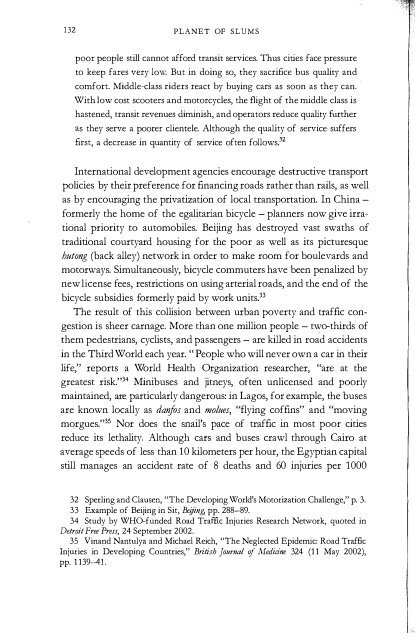Untitled - Rebel Studies Library
Untitled - Rebel Studies Library
Untitled - Rebel Studies Library
Create successful ePaper yourself
Turn your PDF publications into a flip-book with our unique Google optimized e-Paper software.
132 PLANET OF SLUMS<br />
poor people still cannot afford transit services. Thus cities face pressure<br />
to keep fares very low. But in doing so, they sacrifice bus quality and<br />
comfort. Middle-class riders react by buying cars as soon as they can.<br />
With low cost scooters and motorcycles, the flight of the middle class is<br />
hastened, transit revenues diminish, and operators reduce quality further<br />
as they serve a poorer clientele. Although the quality of service suffers<br />
first, a decrease in quantity of service often follows.32<br />
International development agencies encourage destructive transport<br />
policies by their preference for financing roads rather than rails, as well<br />
as by encouraging the privatization of local transportation. In China -<br />
formerly the home of the egalitarian bicycle - planners now give irrational<br />
priority to automobiles. Beijing has destroyed vast swaths of<br />
traditional courtyard housing for the poor as well as its picturesque<br />
hutong (back alley) network in order to make room for boulevards and<br />
motorways. Simultaneously, bicycle commuters have been penalized by<br />
new license fees, restrictions on using arterial roads, and the end of the<br />
bicycle subsidies formerly paid by work units.33<br />
The result of this collision between urban poverty and trafflc congestion<br />
is sheer carnage. More than one million people - two-thirds of<br />
them pedestrians, cyclists, and passengers - are killed in road accidents<br />
in the Third World each year. "People who will never own a car in their<br />
life," reports a World Health Organization researcher, "are at the<br />
greatest risk."34 Minibuses and jitneys, often unlicensed and poorly<br />
maintained, are particularly dangerous: in Lagos, for example, the buses<br />
are known locally as danfos and molues, "flying coffins" and "moving<br />
morgues."35 Nor does the snail's pace of traffic in most poor cities<br />
reduce its lethality. Although cars and buses crawl through Cairo at<br />
average speeds of less than 10 kilometers per hour, the Egyptian capital<br />
still manages an accident rate of 8 deaths and 60 injuries per 1 000<br />
32 Sperling and Clausen, "The Developing World's Motorization Challenge," p. 3.<br />
33 Example of Beijing in Sit, Beijing, pp. 288-89.<br />
34 Study by WHO-funded Road Traffic Injuries Research Network, quoted in<br />
Detroit Free Press, 24 September 2002.<br />
35 Vinand Nantulya and Michael Reich, "The Neglected Epidemic: Road Traffic<br />
Injuries in Developing Countries," British Journal of Medicine 324 (11 May 2002),<br />
pp. 1139--41 .<br />
SLUM ECOLOGY 133<br />
automobiles per year.36 In Lagos, where the average resident spends an<br />
incredible three hours each day marooned in angry gridlock, private<br />
commuters and minibus drivers literally go berserk - indeed, so many<br />
drivers jump curbs or drive on the wrong side of the road that the<br />
Trafflc Ministry has recently imposed mandatory psychiatric tests on<br />
offenders.37 In Delhi, meanwhile, the Hindustan Times recently complained<br />
that middle-class commuters seldom bother to stop after<br />
running over homeless ragpickers or poor children.38<br />
The overall economic cost of road deaths and injuries, according to<br />
the World Health Organization (WHO), is estimated as "almost twice<br />
the total development assistance received worldwide by developing countries."<br />
The WHO, indeed, considers trafflc to be one of the worst health<br />
hazards facing the urban poor, and predicts that road accidents by 2020<br />
will be the third leading cause of death.39 China, where cars are wresting<br />
control of urban streets from bicycles and pedestrians, will unfortunately<br />
lead the way: almost one-quarter-million Chinese were kiJled or seriously<br />
injured in trafflc accidents in the first five months of 2003 alone.40<br />
Rampant motorization, of course, is also exacerbating the nightmare<br />
of air pollution in Third World cities. Myriad old cars, beat-up<br />
buses, and superannuated trucks asphyxiate urban areas with their<br />
deadly exhaust, while the dirty two-stroke engines that power small<br />
vehicles emit ten times as much fine particulate matter as modern cars.<br />
According to a recent study, foul air is most deadly in the sprawling<br />
megacities of Mexico (300 bad ozone smog days per year), Sao Paulo,<br />
Delhi, and Beijing.41 Breathing Mumbai's air, meanwhile, is the<br />
36 EI Arabi, "Urban Growth and Environmental Degradation," pp. 392-94; and<br />
Oberai, Population Growth, Employment and Poverry in Third World Mega-Cities, p. 16<br />
(accident rate).<br />
37 Glenn McKenzie, "Psychiatric Tests Required for Traffic Offenders," ReJNova,<br />
20 June 2003; and Peil, "Urban Housing and Services in Anglophone West Mrica,"<br />
p. 178 .<br />
38 Hindustan Times, 1 February 2004.<br />
39 WHO, "Road Safety Is No Accident!" (November 2003); and Road Traffic<br />
Injuries Research Network cited in Detroit Free Press, 24 September 2002.<br />
40 People 's DailY (English), 24 June 2003.<br />
41 Asim Khan, "Urban Air Pollution in Megacities of the World," Green Times<br />
(Spring 1997); published by Penn Environmental Group). See also: "Commentary:<br />
Urban Air Pollution," in Current Science 77:3 (10 August 1999), p. 334; "World Bank<br />
Group Meets to Clean Up Asia's Deadly Air," Associated Press, 22 July 2003.


